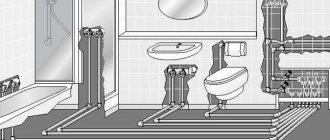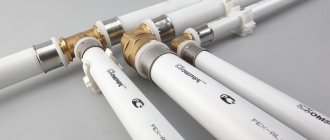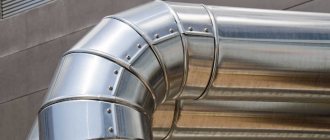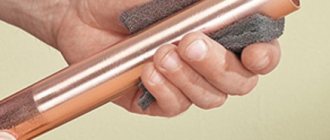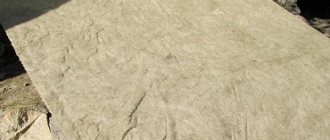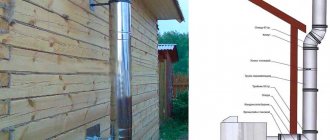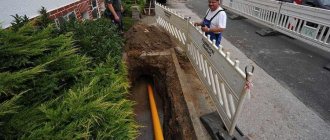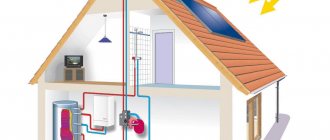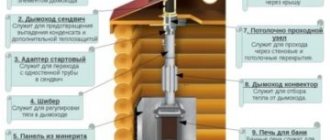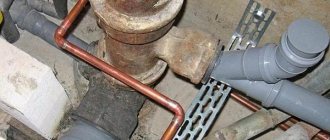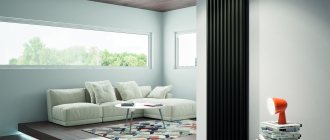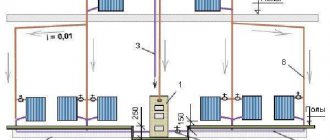Recently, many new materials with improved characteristics have appeared in the construction industry, which have become widely used. One of these is propylene. It is actively used in the construction of facilities and repair work in apartments and houses. Its main area of application is the installation of water supply and heating systems.
When laying pipelines, specialists most often choose products made from this material. The market of polypropylene pipe products The most popular are pipes with a layer of fiberglass reinforcement. This demand for them is mainly due to the unique characteristics that they possess.
Advantages and disadvantages of polypropylene pipes
Solid polypropylene pipes, for which the PPR marking is accepted on the market, are superior to plastic and metal products in many respects. They are inexpensive, durable and lightweight. You can transport products made from this type of plastic to the work site on your own. Installation of such systems does not require special skills or professional equipment. Polypropylene tolerates low temperatures well: its structure is not disturbed even after freezing and thawing of water in the pipeline.
At the same time, products made from solid polypropylene also have characteristics that do not have the best effect on their performance. First of all, this is a fairly low melting point. Polypropylene begins to melt in factory conditions at 175 degrees. This plastic can become soft already at 130-140 degrees.
It would seem that with a stable temperature in the heating system of 90-95 degrees, this limitation can be ignored. But do not forget that when combining the factors of high pressure and high temperature in the system, the influence of hot water has a much more noticeable effect on the durability of the material. Therefore, loss of integrity of polypropylene in sections of the pipeline due to pressure changes is quite likely.
Reinforced pipes are more durable and resistant to temperature changes than conventional ones.
Polypropylene also tends to expand noticeably when exposed to heat. Length deformation usually occurs: the pipes stretch and waves appear on their surface. This phenomenon is undesirable not only for aesthetic reasons. In cases where polypropylene pipes are recessed under a floor screed or embedded in a wall covering, a change in the physical size of the structure will result in cracking of the cement and plaster.
Polypropylene pipes reinforced with fiberglass or aluminum can, if not completely eliminate all the shortcomings of plastic products, then at least improve their characteristics by an order of magnitude. The reinforced layer makes it possible to safely use pipes in any heating and plumbing systems.
Pipe markings and their indicators
The latest development in the field of plastics production is high-temperature polypropylene "Random copolymer" (PPRC type 3). Its main advantages are:
Below are the main physical and mechanical properties of the PPRC material (type 3).
Pipes made of PPRC polymer type 3 can be used as pipeline networks for cold and hot drinking water in residential buildings and administrative buildings; for the operation of installations using compressed air; in heating networks; as a pipeline for agricultural needs; in an industrial pipeline network.
Let's look at the technical characteristics of PP-R three-layer glass fiber reinforced FIBER pipes (PN 20).
Polypropylene pipes reinforced with fiberglass are ideal for autonomous heating and hot water supply systems. However, in order to make the most of the best qualities of this material, you must follow the manufacturer's recommendations. Also, to avoid contact of water with the reinforcing middle layer, during installation you need to use a special trimmer.
On the Internet, users leave many positive reviews about polypropylene pipes.
Which polypropylene pipes are better: fiberglass or aluminum reinforced?
To increase the strength of polypropylene pipes, two types of reinforcement are used: aluminum foil and fiberglass. The aluminum sheet can be perforated, can cover the product from the outside, or can be located in the middle of the pipe between two layers of polypropylene. A layer of fiberglass is always placed inside the polypropylene pipe.
If the pressure in the future pipeline is high, it is better to use pipes equipped with an aluminum layer
Helpful advice! Aluminum reinforcement increases the pipe's ability to withstand high internal pressure. If it is not known exactly what characteristics the pressure in the installed system will have, it is better to purchase pipes with an aluminum frame.
Products with aluminum reinforcement (marked PPR-AL-PPR) have high rigidity, can withstand loads well and are not subject to deformation. The aluminum layer is from 0.1 to 0.5 mm depending on the diameter of the structure. Aluminum foil is connected to the base material using glue. If a low-quality adhesive composition was used during production, the pipes may delaminate. Aluminum-reinforced propylene pipes, manufactured technologically correctly, do not lose their tightness over time.
The presence of aluminum reinforcement requires additional installation operations. Before soldering, the aluminum layer must be cleaned. Without cleaning, the pipeline will quickly cease to function. Firstly, this will happen due to delamination of foil and plastic during melting; secondly, due to the destruction of aluminum due to electrochemical processes in the system.
The peculiarity of polypropylene pipes with fiberglass is that the reinforcing layer in this case is very similar in composition and properties to the base material. When welded to a fitting, polypropylene and fiberglass form a durable alloy that is not subject to delamination.
Therefore, polypropylene pipes reinforced with fiberglass can be called a more versatile, simpler and, most importantly, durable option.
Types of reinforcement
Manufacturers produce two types of reinforced PP pipes. They are reinforced with aluminum foil and synthetic fiberglass. Each of the reinforcing materials has its own characteristics.
Reinforced polypropylene pipe
Aluminum reinforced PP pipe
Aluminum reinforcement implies the placement of metal foil in the wall of the product. Additional material is placed over the entire surface, and its ends are soldered to each other. In products with a low price, they are not fixed, but simply overlapped.
In cross-section, the wall of the reinforced product is a multilayer structure. Here, a metal core is located between two layers of polypropylene.
Types of aluminum reinforcement:
- Solid foil or perforated over the entire area of the material is used;
- the aluminum layer is located strictly in the middle or closer to the outer surface;
- wall in the form of a structure consisting of 3 or 5 layers.
In 5-layer structures, an additional adhesive material is used - glue. It is located between aluminum and PP.
Marking allows you to find out:
- manufacturer's name;
- name of rolled pipe;
- material;
- standard size ratio;
- nominal outer diameter and wall thickness;
- nominal pressure;
- manufacturing standards.
Products with 5 layers are marked PP-RCT-AL-PPR, and three-layer products are designated PP-AL-PPR.
PP glass fiber pipe
Reinforcing pipe products with fiberglass differs from aluminum reinforcement. To give products special qualities, not whole additional material is used, but individual fibers. During production they are mixed with polymer. After this, they are added inside.
The difference between all polypropylene pipes reinforced with fiberglass for heating or other systems is the presence of a monolithic wall. If fiberglass is used in production, then the product is called fiberglass. The abbreviation PPR-FB-PPR is used to mark it.
Characteristics of glass fiber reinforced polypropylene pipes
Fiberglass is a more modern type of reinforcement than aluminum foil. Pipes reinforced with this material have a three-layer structure.
The reinforcing layer of fiberglass is located in the middle of the pipes - between the layers of polypropylene
Moreover, the inner layer, which performs the function of reinforcement, is the same polypropylene, but with the addition of fiber fibers - fiberglass. The characteristics of the adhesion strength of fiberglass to plastic are almost equal to the monolith. Glass fiber reinforced polypropylene pipes are marked as follows: PPR-FB-PPR.
This type of reinforced pipes has many positive properties:
- no likelihood of corrosion in the system;
- the walls of polypropylene pipes are very smooth, which prevents the formation of deposits;
- products have high strength indicators and do not deform under the influence of heat;
- tolerate chemical and biochemical influences well;
- are characterized by low hydraulic resistance, so pressure losses in the system will be insignificant;
- have soundproofing qualities;
- do not change the composition of water, do not emit substances harmful to humans.
Fiberglass essentially acts as a frame that prevents polypropylene from expanding under certain conditions. Fiber fibers do not affect the performance of the pipeline system, but only improve its characteristics. The approximate service life of polypropylene pipes with fiberglass is more than 50 years.
Helpful advice! The characteristics of fiberglass-reinforced polypropylene pipes are inferior to pipes with an aluminum frame, perhaps only in one case. The rigidity of products with fiberglass is much lower, so for systems with a length of more than 1.5 m, it is necessary to use special fastening elements for walls. Otherwise, the pipeline will be deformed due to sagging.
Reinforced pipes must be secured with special clips or clamps, placing them strictly at a certain distance
Pipes with glass fiber reinforcement are produced in various diameters. When choosing the required size, you need to take into account the purpose of the pipeline. Models with a diameter of less than 17 mm are used for laying heated floors, 20 mm - for domestic hot water supply systems. A diameter of 20-25 mm is used for installing heating equipment in public places, as well as for installing sewer risers. The method of fastening the pipes also depends on the diameter: for small ones plastic clips are suitable, for large ones it is better to use clamps.
To clear or not to clear?
Some experts and distribution companies recommend pipes with this kind of reinforcement, since they assure that such pipes do not need to be cleaned.
For readers unfamiliar with the process of installing polypropylene pipelines , let us inform you that the procedure for stripping a pipe (in its classical sense) consists of removing part of the outer layer of polypropylene and aluminum foil from the edge of the pipe so that the pipe and fitting can be welded using socket thermal welding . Some “experts” believe that since pipes reinforced in the middle do not require stripping of the outer layer of polypropylene, it is not necessary to strip them from the end of the pipe. However, it is not.
The process of stripping pipes , especially large diameters, is quite labor-intensive. Many installation companies would be happy to avoid the need to remove the aluminum layer before welding. And when a tempting and easy way to achieve this appeared, some installers, despite the recommendations of the responsible manufacturers, and often without even knowing anything about them, began to install systems without using a stripping (facing) tool.
Ender for pipes reinforced with foil in the middle
End trimmer - inside view
As short empirical experience in the installation and operation of polypropylene pipes reinforced with aluminum in the middle without end stripping of the metal shows, there is nothing critical in the short term. The pipes are welded without stripping as standard, the system is pressurized, water is released, and everything seems to be fine.
In front of you are two pipes. One of them (right) was stripped before connecting to the fitting (the foil is melted, there will be no contact of aluminum with water), the other (left) was not stripped
But, as the thousand-year experience of human civilization shows, free cheese comes only in mousetraps. The main reason why most consumer-responsible manufacturers advise using special end stripping is the rapid electrochemical corrosion of aluminum foil, leading to delamination of the combined pipe and its operational degradation .
Unfinished pipe. Physical degradation and stratification are visible. As a result, leaks and cracking occur over time.
Polypropylene pipes with a smooth inner surface , indeed, do not overgrow and are not subject to corrosion, however, in the case of pipes reinforced in the middle and reinforced “from the inside,” they can not only overgrow (the polypropylene will swell inward, partially blocking the internal section), but also partially rot due to aluminum corrosion.
After reading everything written above, an inexperienced user or installer may exclaim in their hearts: “How confusing everything is! I’ll make a better system using metal-plastic” (approx. the generally accepted name for a pipe with a PEX/AL/PEX layer structure). However, there is no need to rush, everything is actually simple and clear. We take classic pipes with reinforcement closer to the outer edge of the pipe. Bearing in mind that almost any more or less large object has a hammer drill, we buy a special stripping attachment for a hammer drill for relatively little money and, without much effort, using the adjustable torque of the tool, we remove the outer layer of polypropylene along with aluminum. For those who do not have a hammer drill, but have to strip different sizes of pipes, we can recommend a new stripping tool - a manual shaver (stripping) for four main sizes of pipes (20, 25, 32, 40 mm).
These tools are used for stripping aluminum reinforced polypropylene pipes. The photo shows an attachment for a hammer drill, a universal stripping tool for four standard sizes of pipes and a standard stripping tool for two standard sizes
The only pipes that mostly have the properties of reinforced pipes and do not require stripping are the so-called fiberglass pipes . Such pipes have a three-layer structure with a middle layer of compound (mixture), which contains a premix of fiberglass and polypropylene. That is, during the welding process, this layer can also be welded from the end, and even more so it will not enter into chemical reactions and corrode. Since all three layers of these pipes contain polypropylene and are basically the same type, these pipes are produced by coextrusion, i.e. The layers of the pipe are superimposed on each other at one point in time. In this case, there is no need to first pass any layer through a water bath and use connecting layers of adhesive.
Rubis Fiber Glass – three-layer PP-R pipes reinforced with glass fiber. The products are designed to make the work of installers easier, significantly speed up installation and save material. Areas of application: heating, air conditioning, technical and drinking water supply systems
Methods for installing polypropylene pipes with fiberglass
The installation of pipes with fiberglass reinforcement is no different from the connection of solid polypropylene products. There are three methods for installing reinforced structures:
- using threaded fittings;
- cold welding (glued couplings);
- diffuse welding.
The connection with threaded fittings is carried out using circular compression of the mounting nut. The pipe is put on the fitting fitting and pressed with force. The connection is very tight, and it is almost impossible to spoil the parts during the work process. This method can even be used in pressure piping systems. The only thing that may be difficult is the pressing force on the fitting. Too much pressure may cause the nut to burst.
Cold welding, in which the connection is made using a special adhesive composition, does not provide sufficient reliability to the joint. In this case, polypropylene couplings are used, on the inside of which glue is applied. Then a piece of pipe is inserted into the coupling and the structure is held in one position for some time so that the glue sets.
The diffuse welding method is not inferior in strength to a threaded connection. The disadvantage of this technology is that it requires an additional tool - a welding machine. The temperature for soldering is calculated depending on the diameter of the pipe and the thickness of its wall.
Polypropylene pipes with fiberglass reinforcement are today an ideal option for home heating and plumbing systems. Inexpensive and high-quality, they are free of significant drawbacks, and therefore perfectly solve the problems of products made from solid polypropylene and successfully replace conventional metal structures.
How polypropylene pipes are installed in practice
We have all the requirements for such systems reflected in the document SP 40-102-2000; the Western analogue of this set of rules is DVS 2207-1.
Before installation, you need to remember the only rule - installation of polypropylene water supply and heating pipes is prohibited near hot objects (chimneys, stoves, etc.).
Tool
The main tool here is a device for soldering polypropylene pipes, in other words, a soldering iron. Although I have come across such a name online as polypropylene iron.
Nowadays, a homemade soldering iron for welding polypropylene can be bought for about one and a half thousand rubles, the price of a normal factory iron starts from 3,000 rubles.
Polypropylene soldering iron for welding pipes and fittings.
The simplest devices come without a temperature regulator; the heating is set initially (260ºС). Soldering irons with a temperature controller are no different from their automatic brothers; it’s just that adjustable soldering irons can be used for welding other types of plastic, for example, polyethylene.
The soldering temperature for polypropylene pipes is 260ºС.
Every soldering iron has a pair of lights, red and green. So, while the device is heating up, the red light should be on, and when the soldering iron is ready for use, the green light will light up.
The soldering iron comes with special Teflon-coated nozzles. Each nozzle corresponds to the standard diameter of a certain model of pipe or fitting.
Soldering iron attachments.
The second important tool is a pipe cutter or scissors. The price of normal scissors is about 200 rubles, so it’s not worth saving on them. When you buy, choose scissors with replaceable blades so you don't have to pay for sharpening later.
To make a quality cut you need sharp scissors.
For high-quality soldering, you need to remove the chamfer from the pipe after cutting; for this there are 2 devices:
- If you use ordinary solid pipes, then it is enough to buy an inexpensive chamfer;
Regular chamfer.
- For reinforced pipes, you will have to purchase a so-called shaver; this device is used to strip the reinforcing layer. The fact is that if the reinforcement is not removed before soldering, the pipe will then delaminate and the connection will not be of good quality.
Shaver.
How to solder polypropylene pipes
| Illustrations | Recommendations |
| Marking . There is a stop-limiter inside any fitting, so the pipe should not reach it by about a millimeter. Otherwise, the heated polypropylene will crawl inside the pipe and the cross-section will become smaller. | |
| Exact depth . For each section of pipe and fitting, a separate mark is made; there is a special table for this. | |
| Reinforced pipe . As I already said, the reinforced pipe must be stripped down to the bottom layer of polypropylene. | |
| Degrease . The pipe must be degreased with something before soldering. Alcohol or cologne is usually used. | |
| Warming up . Next, put the pipe and fitting on both sides onto the corresponding soldering iron attachments and wait the required time, I usually count 5 seconds. | |
| Splice. · After heating, carefully remove the parts from the soldering iron; · Connect together; · Leave until the polypropylene cools down. The photo on the left shows a table of warming up and holding time during fixation. | |
| Errors. · Strictly control the heating time, do not overheat the parts; · When connecting, the parts are connected directly, under no circumstances should they be twisted; · Insert the pipe into the fitting only up to the marking and no further. In the video in this article, different masters give approximately the same recommendations described above. |
Soldering table for polypropylene pipes of different diameters.
Installation recommendations
Welding and installation of polypropylene heating and hot water pipes are carried out taking into account the coefficient of linear expansion, in this case it is fixed for solid pipes it is 0.15, and for pipes with reinforcement it is 0.03.
This coefficient is tied to the temperature of the coolant, for example, if the water temperature is 80ºC, then for a homogeneous pipe 80×0.15=12 mm, and for a reinforced pipe 80×0.03=2 mm, per 1 linear meter.
The pipes are mounted in plastic sliding holders and so that, when the coolant is heated to maximum, the line does not sag, the distance between these holders must be fixed. There are special tables for calculations, I have given such a table below.
Recommended table for calculating the pitch of pipe fastenings.
If the pipe is fixed on both sides, for example, walled up by opposite walls, then so that when the length increases it does not become deformed, a compensator for polypropylene pipes is installed; it can be L-shaped, U-shaped or circular.
Different types of compensators.
If you have enough funds, then you can buy the so-called Kozlov compensator for polypropylene pipes. Essentially, this is a section of corrugated pipe inserted into a sleeve.
Kozlov compensator.
Installation diagram of the Kozlov compensator.
Theoretically, polypropylene pipes cannot be poured into concrete, but there is one interesting solution. Before pouring into concrete, a “jacket” of foamed polyethylene is put on the pipes; such braids are available in abundance on any construction market.
Polyethylene is wrapped over the jacket, after which the system is filled with concrete. With this approach, the pipe does not come into direct contact with the concrete, and therefore is not fixed. Only here it’s no longer worth saving on Kuznetsov’s compensators.
Foamed polyethylene for pipes of different diameters.
Before laying pipes, it is advisable to draw the entire line on the wall, then mount the holders, and only after installing the holders can you begin laying and soldering the system.
It is advisable to draw the route in advance.
List of running fittings
| Illustrations | Recommendations |
| The coupling is straight . For soldering straight sections of line. | |
| Elbow 90º . To rotate a line 90º. | |
| Elbow 45º . To rotate the line at 45º. | |
| Tee 90º . For arranging wiring at 90º. | |
| American women . Adapters for metal pipes or fittings of other diameters. There are American ones with internal and external threads. | |
| Tap adapter . Installation of taps on polypropylene pipes is carried out using special adapters. | |
| Adapters for mixer. The mixer can be installed on polypropylene pipes using three types of adapters. Shown on the left is a straight outlet fitting and an elbow fitting. But now there are also paired fittings on the bar, specifically for the size of the mixer. | |
| Bypass. This part is designed to go around the pipe in one plane. Sometimes, to make the system even more compact, 2 loops are installed at the intersection at 90º, so that one loop fits into the other. | |
| Fastenings . Wall clamps for pipes can be attached either individually or as a whole tape, connecting to each other. | |
| Stub . Closes the end point of the line. | |
| Ball valve. (26) It makes sense to install a polypropylene ball valve only if it is not intended to be actively used, since it is not reliable. If the faucet will be constantly running, then it is better to install a metal one. |
Welding and installation of polypropylene pipes video:
